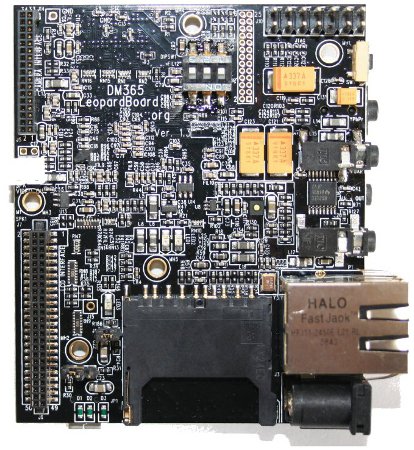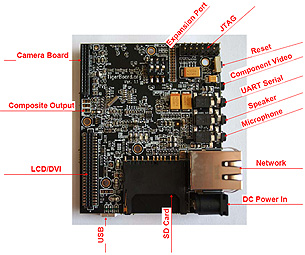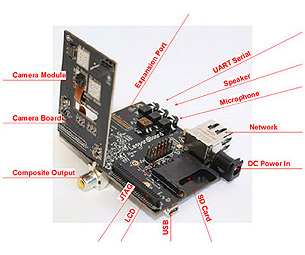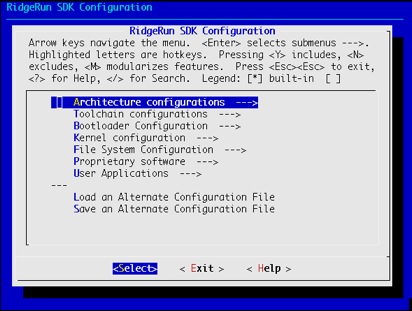Imaging boards tap 720p-ready DaVinci chips
Feb 25, 2010 — by Eric Brown — from the LinuxDevices Archive — 23 viewsLeopard Imaging is shipping two Texas Instruments DaVinci-based vision/imaging development boards supported by the company's Designsomething.org development community. The $84 Leopard Board 355 and $129 Leopard Board 365 tap TI's TMS320DM355 and TMS320DM365 processors, respectively, support 720 video, and ship with a Linux SDK from RidgeRun, says the company.
When Texas Instruments (TI) announced its TMS320DM365 (DM365) processor last March, it also announced the availability of an HD-ready LI-5M02 camera kit from Leopard Imaging, based on a Micron/Aptina five-megapixel CMOS sensor designed for 720p HD cameras. While the LI-5M02 plugged into TI's DM365 DVEVM evaluation board, the new Leopard Board 365 integrates the DM365 processor directly into a development board of its own. The Leopard Board 355, which appears to have been shipping for a while, offers a similar configuration, but uses the earlier, low-cost TMS320DM355 (DM355) processor.

Leopard Board 365
(Click to enlarge)
In addition, each of the boards is available with royalty-free open source 2A functions, technical support, user guide, a bill of materials, schematics, PCB layout and gerber files, and the RidgeRun Linux SDK (see farther below). Leopard Imaging's Designsomething.org development community site supports the boards with forums, documentation, and software download pages, says the company.

Leopard Board 365 detail
The DM365's "on-chip image tuning tool" provides video stabilization, face detection, noise filtering, auto white balance, auto-focus, auto-exposure, and edge enhancement, says Leopard Systems. The enhanced subsystem also offers additional video quality enhancements for image improvements, as well as added intelligent video processing, says the company.

Leopard Board 355 detail
Standard features on both boards, which share the same 3.0 x 2.5-inch (76.2 x 63.5mm) dimensions, include 128MB DDR2 SDRAM, expandable to 1GB, and 256MB NAND flash, expandable to 2GB. The boards are also said to offer SDIO-compatible SD memory card support.
I/O includes a 10/100 Ethernet port, and a USB 2.0 port, which can be used for power or expansion purposes, says Leopard Imaging. Other common features are said to include JTAG and serial ports for debugging, stereo audio I/O, and a cross-compatible expansion connector for plug-in camera boards. The 365 model also provides a new plug-in configuration in which the camera board can lie flat against the board rather than sit at a 90 degree angle (see video demo farther below).
Whereas the Leopard Board 355 ships with a VGA camera board pre-installed, it appears that the 365 model may ship without a standard camera board, but supports all camera boards that run on the Leopard Board 355. Leopard Imaging claims that the 355 model supports camera boards with resolutions ranging up to five megapixels, as well as 720p, 30fps video, yet the 365 model may be preferable for working with the higher resolution sensors and video modes. This is suggested by the fact that the RidgeRun API for the 365 adds support for DVI, 720p HD, and five-megapixel sensors — features not available with the 355's SDK.
Both boards provide an LCD/DVI interface and a Composite TV connection, says Leopard Imaging. The Leopard Board 365 is said to add a Component HD out connection that can be extended via an optional DVI add-in board, including a HDMI interface.
RidgeRun Linux SDK
The open source Linux SDK from longtime Davinci software support firm RidgeRun is available in separate configurations for each board. As previously mentioned, the DM365 version adds support for DVI, 720p, and a five-megapixel sensor.

RidgeRun SDK interface
Core features of the RidgeRun SDKs are said to include:
- Linux 2.6 kernel with real-time patches (kernel version depends on the specific hardware)
- GCC 4.1 or up with soft-float ARM processor support or floating point (and NEON) support for ARMv7
- uClibc or glibc based toolchain
- NPTL thread library (also available in uClibc)
- EABI support on ARM targets
- gdbserver and gdb for system debugging with debugging support from Eclipse CDT.
- Support contract (10 or 60 hours) included
- Current fixes, tuning and patches
- Oprofile system profiling
Leopard Board 365 demo on YouTube
(Click to play)
The $84 Leopard Board 355 (LI-LB01) and $129 Leopard Board 365 (LI-TB01) are available now via Arrow, Avnet and Farnell distributors, along with a free RidgeRun Linux SDK, says Leopard Imaging. More information may be found here. More on the RidgeRun SDK may be found here.
This article was originally published on LinuxDevices.com and has been donated to the open source community by QuinStreet Inc. Please visit LinuxToday.com for up-to-date news and articles about Linux and open source.